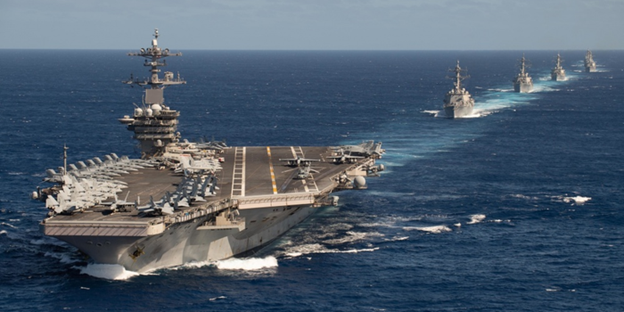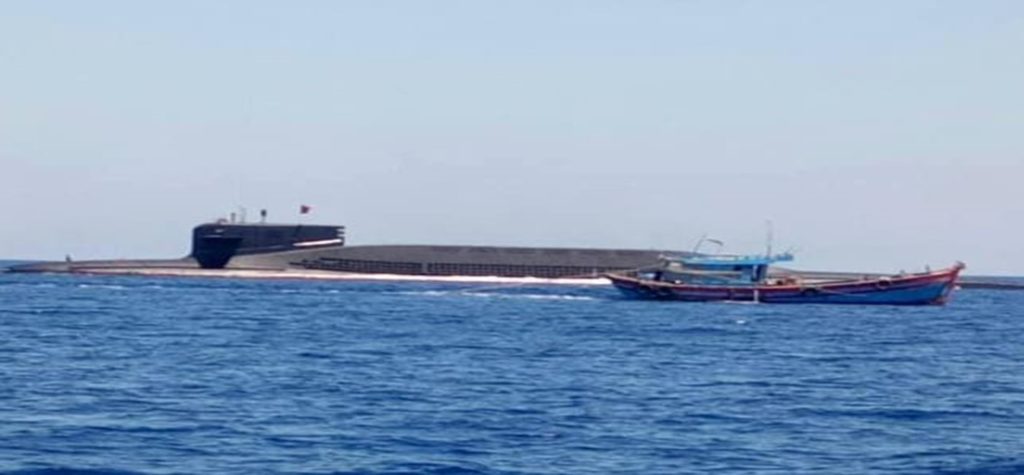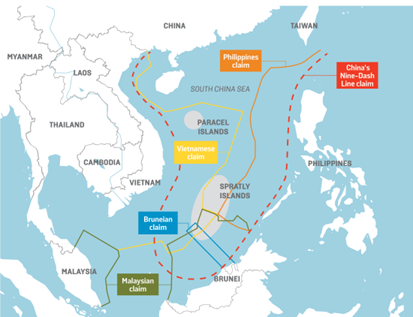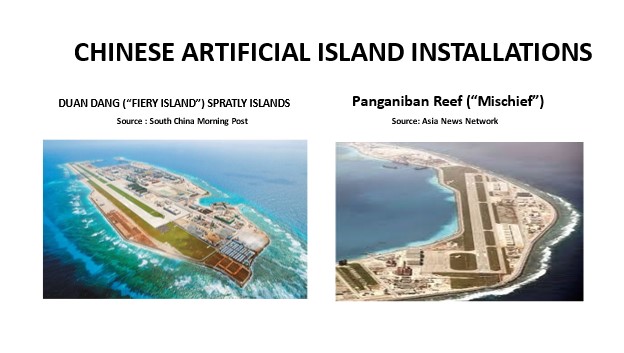

Date: 1/25/2021
Author: Kent Moors, Ph.D.
This weekend the USS Theodore Roosevelt carrier task force entered the South China Sea (SCS). The task force, titled Carrier Strike Force Nine by those in the inside, also includes the Ticonderoga-class guided-missile cruiser USS Bunker Hill, and the Arleigh Burke-class guided-missile destroyers USS Russell and USS John Finn, according to a statement released by the US Navy Pacific Fleet in San Diego.


The entry into contested waters came a day after mainland Chinese fighters penetrated the air space of Taiwan. The island nation is both a source of Beijing’s ire and an erstwhile US ally. The US has labeled its move a “freedom of navigation” exercise, a catch all phrase used previously in SCS operations against China and Strait of Hormuz/Persian Gulf fronts against Iran.
SCS is a part of the world where events are escalating in a way I haven’t seen since my active-duty days in the U.S. intelligence community. It has also been a situation with which I have had some ongoing personal involvement.
My last public briefing on the crisis occurred about twelve months ago in London before executives of cargo/tanker fleets and insurance carriers who plied those waters. Given that some two-thirds of the world’s daily sea traffic moves through the SCS, these would be the parties most interested in the economic impact of a festering geopolitical storm.
Shortly thereafter, I assumed a position (with Washington’s approval) as an advisor on policy matters to Petrovietnam (PVN), the Vietnamese national oil company. How history changes. Some fifty years ago, I was learning my intel ropes in Vietnam for quite different reasons. Now the US is supporting Vietnam in the SCS.
Their offshore “exclusive economic zone” (EEZ) has been interdicted on several occasions by the Chinese military threatening reprisals against both PVN and foreign oil companies developing natural gas production projects with them.
The latest and most serious occurred when the Chinese oil surveying ship Haiyang Dizhi 8, escorted by as many as ten support and military vessels, incurred into both Vietnamese and Malaysian territorial waters. Contacts at both PVN and Malaysian national oil company Petronas confirmed that the Chinese military required immediate cessation of offshore work or the companies would suffer a military reprisal.
All work was halted and foreign drilling ships withdrew from the zones.
This has been happening in various locations within the disputed area in an on-again-off-again Chinese operation for the last several years. Upon occasion, it can be rather dramatic. At least one Vietnamese commercial fishing boat has been sunk by Chinese naval gunfire. And there is this.
Below is a cell photo sent by a PVN contact last year – showing a Chinese type 094 (Jin Class) nuclear weapons armed submarine surfacing inside a Vietnamese fishing fleet in contested waters. I doubt they were looking to buy sushi for lunch!


While the SCS’s lynchpin position in water trading traffic makes it a major conflict threat, the presence of offshore oil and natural gas reserves are also a major consideration. With the focus of global energy demand rapidly moving to Asia, such reserves are becoming an important issue in their own right.
SCS has become the center for what could be the most concerted geopolitical contest since the Cold War. This one, however, has all the earmarks of a conflict moving from the diplomatic to the military. The US carrier task force entrance into the area over this weekend is the latest move in a potentially deadly game of geopolitical chicken.
My consulting gig contractually ended a little over two weeks ago (on January 8) with the US Department of State awaiting decisions to be made by the incoming Biden Administration. That allows me to comment generally on the latest developments.
The previous Trump Administration had provided no policy priorities for the SCS beyond ticking off Beijing in tweets or receiving phone calls from Taiwan. That provided another salient example of an axiom in American politics: those devices directed toward domestic politics and instrumental in securing office often end up being the worst bases upon which to run foreign policy.
Such posturing made my job even more difficult. I have held several such global advisory positions. In each case, my role is to advise only. I cannot represent the US government nor can I replace a local official in any decision-making responsibility. But with no directions coming through diplomatic channels, my ability to advise was substantially reduced and the frustrations intensified.
While the current transition is underway in Washington, however, it is hardly unexpected that China will be moving to advance its interests. The order to put Carrier Strike Force Nine in the SCS, on the other hand, was made before the US Presidential Inauguration on January 20.
In fact, the SCS disagreement has been intensifying for years. In addition to primary shipping routes, the prize includes crude oil and natural gas reserves.


It is the hydrocarbons that have accelerated the controversy and involved claims of ownership from countries including Vietnam, Malaysia, Indonesia, and the Philippines, as well as mainland China.
The estimates of what may be at stake vary widely. The US Energy Information Administration (EIA) estimates 3P (proved, probable, possible) reserves at 11 billion barrels (BB) of oil and 190 trillion cubic feet (TCF) of natural gas. The US Geological Agency (USGS), on the other hand, put the total as low as 2 BB oil and 10 TCF gas. Of course, USGS also has a ceiling of 22 BB and 290 TCF for its estimate range, so the real amount is anybody’s guess.
The problem is this. Aside from contested areas directly off the Paracels and Spratly Islands (see the map above) where there are at least some initial estimates, everything beyond the current national EEZs are blue water areas with little if any exploratory work.
Yet this has hardly lessened the cross-border disagreements.
Beijing has relied upon the so-called “nine dash line,” a demarcation introduced in 1947 to lay claim to a series of SCS islands. The “line” was later increased to a “ten” and an “eleven” dash configuration.


However, the Permanent Court of Arbitration in The Hague rejected this approach in a suit advanced by the Philippines. The Court declared that China has no grounds predicated upon historic rights to use the line. The ruling said there was no evidence that China had historically exercised exclusive control over the waters or resources within the area demarcated by the nine dash line. Needless to say, Beijing rejected the decision.
Instead, for the past several years, China has been expanding its military presence, combining the occupation of existing islands and the construction of new artificial ones. If anything, that process of building military bases from nothing has been ramped up of late. The two below are the latest and both are man-made. Duan Dang is a naval support base, while Panganiban is an air force base.


The intensity of the Chinese moves is high on the agenda of knowledgeable watchers in Asia. Among the best is a Hong King-based colleague of mine from earlier operations and part of my network. He currently writes for one of the few operating Hong Kong newspapers still having some independence from the official media. In a personal email memo, he reviews the situation, and the Chinese limitations usually not discussed, as follows:
Kent, in response to our latest discussion, I believe it is no secret what the mainland is doing in SCS. No one is surprised when they hear of another dredging operation to reclaim an island, or when another runway pops up on satellite imagery where before there were only idyllic, turquoise waters.
The recent arrival of fighter aircraft along with evidence of anti-aircraft reinforcements is meant as a clear statement of intent. But there remains a very pertinent question which has had little attention – what can they achieve with this collection of runways?
On the face of it, the answer seems clear – to project air power in the region. China’s political goal is to claim vast swathes of SCS marked out by the “nine- dash line,” a border of questionable historic merit. This claim would allow exploitation of the 200-mile EEZs established around sovereign territory as well as establishing China as the dominant force in the region.
China wants to maintain a presence on these islands to reinforce the legitimacy of its claims while filling them with aircraft in order to defend them. The problem is that, historically speaking (and as you well know), air power has a poor record of achieving wider strategic goals.
Some examples where it has worked well consist of military campaigns where strike aircraft are used in a close air support role working with ground troops to attack specific targets. The evidence seems to suggest then that air power is most effective in the tactical or operational spheres and less so in the strategic.
Ultimately, previous air power campaigns failed either because leaders didn’t appreciate the galvanising effect cold and remote attacks can have on a civilian population, or because an air force cannot be omnipresent and, once clear, the enemy has calmly continued their work.
On the first point, China has already tested the waters by sinking a Vietnamese fishing boat last year, resulting in a major diplomatic backlash and growing anger amongst Vietnamese people. The majority of popular opinion has strengthened against China, which may have further implications for the regional power, especially if other claimants can cooperate and channel their demands through ASEAN [note: the Association of Southeast Asian Nations].
The second point relates to the practical considerations about what China can actually do with the aircraft stationed on the islands and how far it is prepared to go. The People’s Liberation Army Air Force (PLAAF) recently stationed Shenyang J-11 aircraft on the main airstrip protecting the Paracel Islands, known as Woody Island or Yongzing. The J-11 is an air superiority fighter with a combat radius of 1,500 kilometers putting most of [SCS] in its crosshairs. Its primary function is to clear an airspace of the enemy but doing so is a means, not an end. They are most likely the start of a military build-up in the area which will include ground attack and reconnaissance planes.
China will back up its claims until the point where others would be forced to defend their interests and, as the biggest player, the United States has made its position very clear. The U.S. Air Force and Navy regularly conduct “freedom of navigation” exercises undermining the integrity of the claim.
In the event of all-out war, these outposts and runways are dangerously exposed. Despite bordering nations not having the firepower of China, they would take significant resources to defend.
Likely sources of upcoming conflict include unintended interactions between navies, as well as resistance to China’s exploitation of oil and gas within their EEZ. An oil rig constructed to the west of the Paracel Islands stands mockingly close to Vietnamese waters whilst Reed Reef, a source of natural gas and oil within the Philippines, has been repeatedly harassed by Chinese vessels – a land grab Filipinos would regard as the final straw.
At present, we have a stalemate – fourth-generation fighter aircraft parked in the sun, their contribution too large a gesture to bring against minor infractions, their presence symbolic only.
This stalemate is now at tender hooks. As global energy needs continue to gravitate to Asia – where the bulk of international demand will be generated over the next several decades – control over SCS resources will continue to present a major flash point. China certainly will not relent and that means the U.S. will be progressively drawn into this regional quagmire.
This is probably going to get worse, and shortly.


Dr. Kent Moors
This is an installment of Classified Intelligence Brief, your guide to what’s really happening behind the headlines… and how to profit from it.
Dr. Kent Moors served the United States for 30 years as one of the most highly decorated intelligence operatives alive today (including THREE Presidential commendations). After moving through the inner circles of royalty, oligarchs, billionaires, and the uber-rich, he discovered some of the most important secrets regarding finance, geo-politics, and business. As a result, he built one of the most impressive rolodexes in the world. His insights and network of contacts took him from a Vietnam veteran to becoming one of the globe’s most sought after consultants, with clients including six of the largest energy companies and the United States government.
Now, Dr. Moors is sharing his proprietary research every week… knowledge filtered through his decades as an internationally recognized professor and scholar, intelligence operative, business consultant, investor, and geo-political “troubleshooter.”
This publication is designed to give you an insider’s view of what is really happening on the geo-political stage. You can sign up for FREE to Classified Intelligence Brief and begin receiving insights from Dr. Moors and his team immediately.
Just click here – https://classifiedintelligencebrief.com/






